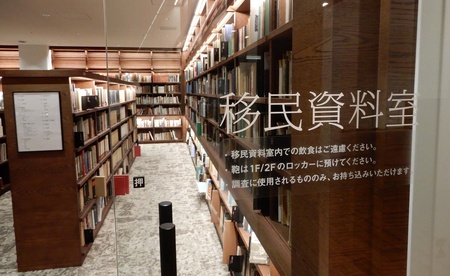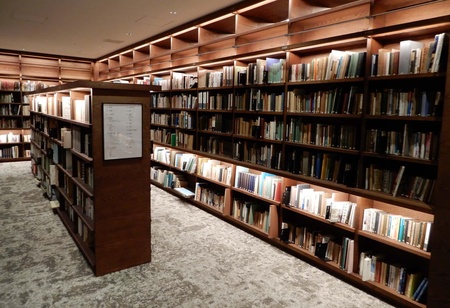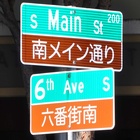Wakayama Prefecture is an "immigration prefecture" that has produced many immigrants, as seen in the American Village in Mihama Town, Wakayama Prefecture, which faces the Kii Channel, and I had heard that Wakayama City has a facility that respects this history, the Immigration Materials Room, which collects materials related to not only Wakayama Prefecture but also immigrants. I had always wanted to visit it, so after leaving Mihama Town, I headed north along the coastline and visited the Wakayama City Library and Immigration Materials Room in Wakayama City.
Speaking of facilities that collect books and materials related to immigration, there is a reading room in the Overseas Migration Museum run by JICA (Japan International Cooperation Agency) in Yokohama, but the Wakayama immigration materials room is probably the only one of its kind among public libraries.
Wakayama City Library, which occupies part of the Kino Wakayama complex building directly connected to Wakayama City Station on the Nankai Electric Railway, has a slightly different atmosphere from ordinary public libraries. Before introducing the immigration materials room, I would like to explain the library itself.
The library, which opened in June 2020, is managed by Culture Convenience Club Co., Ltd. (CCC) in partnership with the library, and the library occupies the first to fourth floors, as well as the rooftop. On the first floor, which has a spacious feel, there is a Starbucks cafe and a Tsutaya bookstore next to the library, where you can read books you have purchased or borrowed.
It is open every day from 9:00 am to 9:00 pm, and is open all year round. Kannai is fully equipped with Wi-Fi and has 130 seats with power outlets. The number of books at the time of opening is about 500,000. It is an open library where domestic residents can borrow books outside the library.
The inside of the building has a relaxed salon-like atmosphere. Among them, the immigration information room is located in a section on the third floor. I visited around 8pm, so there were no visitors. Dark brown bookshelves are lined up on the carpeted floor. There seems to be still room on the shelves, so the number of materials will probably increase in the future.
The museum also has books and magazines about immigration, Japanese-language newspapers that were once published overseas, and microfilm copies of newspapers such as the São Paulo State Newspaper that was published in Brazil before the war.
As I browsed the shelves, my eye was drawn to books such as "Days at the Jakarta Japanese School" (Ishii Mitsunobu, Kindai Bungeisha, 1989), "The Blank History of Immigration: New Caledonia and Okinawa" (Miki Ken, Cinema Okinawa, 2017), "Japanese-Indonesian: Former Japanese Soldier Hassan Tanaka's War of Independence" (Tochikubo Hiroo, Simul Publishing, 1979), and "Diary of America's Top Intelligence Soldier" (Karl Yoneda, PMC Publishing, 1989).
A distinctive library
Wakayama City Library first opened in 1981, and the Immigration Reference Room was established three years later in 1984.
"At the time, there was a boom in public libraries, and Mayor Ujita Shozo wanted to create something unique, so since Wakayama had a lot of immigrants, the Immigrant Materials Room was created," explains Higuchi Hina, who is in charge of the library's Immigrant Materials Room.
Former Mayor Ujita had a deep knowledge of immigration, having been a relative of the painter Henry Sugimoto, who was imprisoned in an internment camp in the United States during the Pacific War and wrote about his experiences.
The library's website lists the objectives of establishing the immigration materials room. Five points are listed, but to summarize: 1. To pass on the history of Japanese immigration to future generations. 2. To position immigration as an important part of the local history of Wakayama, a prefecture of immigrants. 3. To deepen international understanding, especially among young people, by passing on the history of Japanese immigration. 4. To use the materials to teach the history of Japanese immigration to children and students in schools. 5. To use the immigration materials as material to advocate for human rights and peace.
Given that Japan today needs to discuss the acceptance of immigrants, I am convinced that the aim is to deepen international understanding through the history of immigration, and that it is important for the younger generation to learn about the history of immigration in order to gain international understanding.
Japanese society tends to place importance on organizations and groups. Whether it be the nation or a company, people look coldly at those who leave or secede from them. This is well expressed in the expression "abandoning one's country" when referring to those who leave their hometown.
It cannot be denied that a similar view was held about immigration, something that is separate from the essence of Japan. In that sense, the purpose of the Immigration Resource Center, which emphasized the significance of learning about immigration, a topic that has rarely been covered in textbooks, is noteworthy.
The library has about 10,000 books, all of which are on open shelves. Some books have been donated by researchers, and users include researchers as well as the general public.
"Recently, more and more people are coming from abroad to search for their roots," says Higuchi. Old address books and name directories can sometimes provide clues.
In October, the Wakayama Prefecture World Championships will be held.
Wakayama Prefecture held its first Wakayama Prefecture World Convention in November 2019. The purpose of the convention was to bring together members of the Wakayama Prefectural Association both in Japan and overseas, to increase pride in their hometown, promote interaction among the prefecture's residents, and deepen the residents' understanding of the prefecture's immigration history.
Four years have passed since then, and the "2nd Wakayama Prefectural Association World Convention" will be held from October 5th. This kind of prefectural convention on a global scale is the successor to the "Worldwide Uchinanchu Convention" in Okinawa Prefecture, which has been held roughly every five years since 1990, and shows a high level of awareness of the Wakayama network through immigrants.
Participating prefectural associations from overseas include Argentina, Brazil, Eastern Canada, Mexico, Paraguay, Peru, Southern California, Seattle Kishu, and Thursday Island (Australia). From October 5th to 8th, participants will experience Wakayama traditions and culture in various locations throughout the prefecture, interact with each other, and discuss the future of prefectural associations.
The last time, there were about 280 participants, but this time it is expected to be about 500. In line with the Prefectural Association World Convention, the Immigrant Reference Room is holding an exhibition called "Preparing for the Immigrant Journey" until the end of November. The exhibit shows what kind of things and how people from the local area who crossed the sea in the past prepared themselves before setting off on their journey. There are also documents such as passports from that time.
It is expected that some of the overseas participants in the World Conference will visit the Immigration Resource Center to learn about the thoughts of their ancestors and to research their own roots.
© 2023 Ryusuke Kawai









